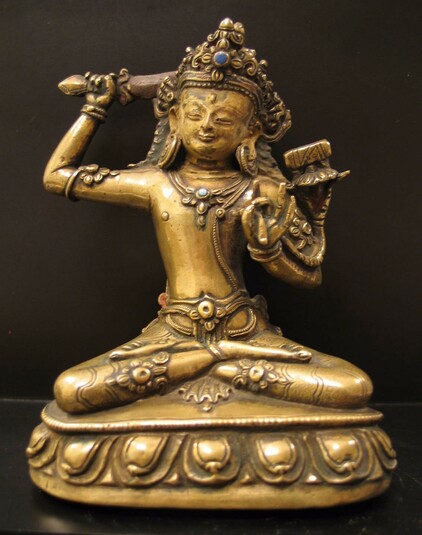
Item: Manjushri (Bodhisattva & Buddhist Deity) - Arapachana
| Origin Location | Tibet |
|---|---|
| Date Range | 1300 - 1399 |
| Lineages | Buddhist |
| Size | 13.70cm (5.39in) high |
| Material | Metal, Painted Face/Hair, Precious Stone, Stone Inset: Turquoise, Lapis Lazuli |
| Collection | Nyingjei Lam |
Classification: Deity
Appearance: Peaceful
Gender: Male
Arapachana Manjushri (Tibetan: a ra pa cha na jam pal yang, mar ser. English: Orange Arapachana the Splendid Melodious Voiced One). The bodhisattva that represents the wisdom of all the buddhas of the ten directions and three times.
Arapachana Manjushri is a meditational deity in Vajrayana Buddhism. He is generally classified as either Kriya or Charya Tantra. In terms of function Manjushri is typically categorized as a wisdom deity - meaning a meditational deity that promotes the increase of wisdom, knowledge, memory, language skills, etc. There are several different forms of Arapachana Manjushri and there are several forms of Manjushri that look like Arapachana but are not.
Sanskrit: Manjushri Tibetan: Jam pal yang
Tibetan: Jam pal yang
"...Arya Manjushri with a body orange in colour, having the colour of fresh saffron, one face and two hands. The right holds aloft the sword of wisdom severing ignorance and in the left the stem of an utpala to the heart, blossoming at the ear with the Prajnaparamita book above. With the feet seated in vajra posture, having jewel ornaments and upper and lower garments of silk, the hair tied to the left in five tufts - [some] loose; having the appearance of a youth of sixteen years. A moon disc with the nature of light supports the back." (Sakya Lotsawa Kunga Sonam (1485-1533), 23rd Throne Holder of Sakya. sGrub Thabs Kun bTus, vol.2, fol.258-261. Translated into English by (c)Jetsun Kusho Chimey Luding and Jeff Watt. May 1984).
Lineage: Holy Manjushri, Mahasiddha Jetari, Ashokanta Shri, Vajrasana the Senior - Lalitavajra, the Younger - Amoghavajra, Bari Lotsawa, Tsechen Kunga Nyingpo, Sonam Tsemo, Dragpa Gyaltsen, Jamgon Sakya Pandita, Palchen Gvalo, etc.
"He whose intellect is free of the clouds of the two obscurations, completely clear like the sun, seeing, however many all meanings as they are, holds a book to his heart.
Discoursing with sixty separate melodious tones and a love for all the hosts of beings tormented by suffering, covered with the darkness of ignorance in the prison of existence, like for an only child.
Roaring loudly like a dragon to wake from the two afflictions, to free from the shackles of karma, and to clear the darkness of ignorance; severing the seedlings of misery, however many, holding a sword.
Pure from the beginning and reaching the tenth stages end, a complete body of qualities; principal form of the Buddha's sons.
Adorned with one hundred and twelve ornaments, clearing the darkness of my intellect; homage to Manjushri-ghosha." [Five Hundred Panditas Prayer. Translated by Jeff Watt, Vancouver, Canada. May 1984].
Jeff Watt [added 9-2023]
Exhibition: Wutaishan, Pilgrimage to Five Peak Mountain
Thematic Sets
Buddhist Deity: Manjushri, Arapachana (Main Page)
Buddhist Deity: Manjushri Sculpture Page
Collection of Nyingjei Lam (Deities)
Collection: Sotheby's New York (Sculpture, September, 2023)
Buddhist Deity: Manjushri Main Page
Collection of Nyingjei Lam

